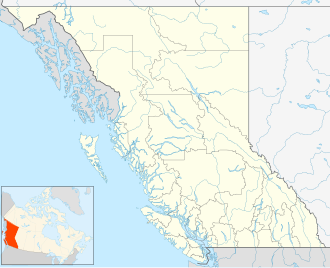| Lava Forks Provincial Park | |
|---|---|
| Location | Kitimat-Stikine, British Columbia, Canada |
| Nearest city | Telegraph Creek |
| Coordinates | 56°27′00″N 130°54′00″W / 56.45000°N 130.90000°W / 56.45000; -130.90000 |
| Area | 7,463 ha (28.81 sq mi) |
| Established | January 25, 2001 |
| Governing body | BC Parks |
| Website | Lava Forks Provincial Park |
 | |
Lava Forks Provincial Park is a provincial park in northern British Columbia, Canada. It is the site of Canada's most recent volcanic eruption, which occurred around 1904 at Lava Fork (see The Volcano).[2][3]
This park lies within the traditional territory of the Tahltan Nation.[4][5]
Recreation and tourism
[edit]The park is offers spectacular scenery, with especially unique volcanic landforms and features from the 1904 eruption of The Volcano.[2] These features include lava-dammed lakes, ash dunes, pot holes containing crystal clear pools, and lava flows.[4]
Walk-In/Backcountry/Wilderness Camping is permitted.[2]
Fishing and angling is permitted provided the angler has the appropriate licenses.[2]
Location and access
[edit]The park is only accessible by helicopter. Foot access is possible, but requires multiple days of hiking.[4] There is no water or road access to the park.[4] It is located about 120 km southwest from the Telegraph Creek community.[2]
The southern boundary of this park United States-Canada border, and is adjacent to the Tongass National Forest in Alaska.[4]
See also
[edit]References
[edit]- ^ "Protected Planet | Lava Forks Park". Protected Planet. Retrieved 2020-10-31.
- ^ a b c d e "Lava Forks Park". bcparks.ca. Retrieved 2024-03-10.
- ^ "Lava Forks Park". BC Geographical Names.
- ^ a b c d e British Columbia Ministry of Water, Land and Air Protection Environmental Stewardship Division. 2003. Skeena Region Management Direction Statement for Lava Forks Provincial Park. Retrieved from BC Parks website: https://bcparks.ca/planning/mgmtplns/lava_forks/lava_forks.pdf?v=1608273827922
- ^ UBC Museum of Anthropology. 2003. Mehodihi WELL-KNOWN TRADITIONS OF TAHLTAN PEOPLE. Tahltan People Sourcebook. Retrieved from Tahltan Central Government website: https://moa.ubc.ca/wp-content/uploads/2014/08/Sourcebooks-Mehodihi-TAHLTAN-PEOPLE.pdf
| Ranges | |
|---|---|
| Mountains | |
| Passes | |
| Icefields | |
| Parks | |
This British Columbia protected areas related article is a stub. You can help Wikipedia by expanding it. |
